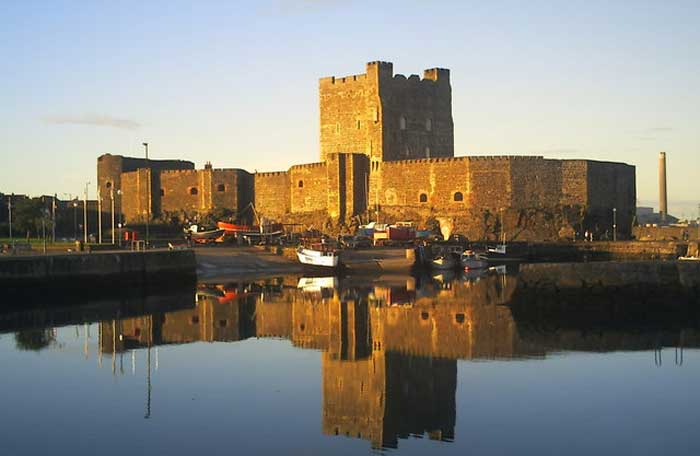© Photo by Stewart from Wikicommons
Where is Carrickfergus Castle?
Carrickfergus Castle
Carrickfergus
Co. Antrim
Opening Hours of Carrickfergus Castle
Easter to September – Monday to Sunday: 1000 – 1800.
October to Easter – Monday to Sunday: 1000 – 1600
Pricing to go in to Carrickfergus?
Adult: £5
Senior: £3
Child (4-16): £3
Child (under 4) £0
Student: £3
Family (5 members):£13
Group (10+)£3
Groups must pre-book
What are the Tours at Carrickfergus
Self-Guided tour.
Information Boards.
Information Booklet and Map.
Last admission 30 minutes before closing.
Contact Information
Carrickfergus Castle, Marine Highway, Carrickfergus, Co. Antrim BT38 7BG
Facilities at Carrickfergus
Gift Shop
Toilets
Parking Available
Limited disability access
The History of Carrickfergus
Carrickfergus is a Medieval Castle so soaked in the Military History of Ireland that the walls seem to be filled with ghostly whispers of battles and bloodshed.
One of Ireland’s oldest and most spectacular Castles, Carrickfergus has withstood the ravages of time seeing eras of war and violent unrest since its inception after the Norman Conquest of Ireland.
[eletter_signup]
Soaked in history and legend this epic and dominant fortress is a must see for anyone visiting Ireland. Although now a living museum telling its life story it is still a living and breathing fortress.
This dominant and impressive structure tells the epic tales of Ireland and its turbulent past.
Its high walls seem to call you in and will you to learn more about the past that shaped and preserved this monumentally epic Castle.
Carrickfergus Castle is perfectly and statistically situated on the north shore of Belfast Lough in the picturesque historical town of Carrickfergus, County Antrim.
It is the largest Norman Castle in Northern Ireland. Its long and extraordinary military history has fascinated for as long as it has been in existence.
From a Military stand point Carrickfergus is strategically positioned so that it would have been easily defended, at the time of construction and during its life it was surrounded by water on 75% of the perimeter.
Carrickfergus was built by the powerful Anglo Norman Knights John De Courcy in 1177, after he conquered the last King of Ulaid (an ancient Irish kingdom in Ulster), he waged this conquest without the permission of King Henry II and installed himself as Petty King.
He designed and built it to be his seat of power to oversee the lands of East Ulster he had conquered and he ruled until 1204 as Petty King, when he was ousted by the famous Norman, Hugh De Lacy (Trim Castle).
John De Courcy also built Dundrum Castle in County Down. He was deposed by De Lacy in 1204 but tried to win back his lands in 1205 with the help of Norse warriors, he lost and as punishment for his crimes against the Crown, he was imprisoned for the rest of his days, by King John.
Carrickfergus dominates with its commanding presence over Carrickfergus Bay (Belfast Lough) with its huge defensive polygonal curtain walls and massive eastern gate.
De Courcy’s design included many of the internal buildings. As with most Norman strongholds a walled town developed outside the main castle walls.
The first written record of Carrickfergus Castle occurs when King John of England laid siege to the Castle in 1210, He took control of the Castles large garrison.
He felt that the Norman Lords in Ireland had become too powerful and appointed constables to oversee his Irish interests. In 1217 a new curtain wall was built to protect the castle from all sides and angles, much of which survives today along with its fascinating crossbow loops that are situated at the basement level of the castle.
Carrickfergus has some of the finest features of Norman defensive architecture in existence with murder holes, vaulting and a huge portcullis.
Hugh De Lacy died before he could finish his improvements of Carrickfergus Castle; the work was continued and completed by King Henry III of England.
[eletter_signup]
Carrickfergus Castle remained the Crown’s main administrative centre in Ulster and was also the Crown’s main residence in Ulster even after the Earldom of Ulster collapsed. The Castle survived the Nine Years War, even when English control of Ulster was in jeopardy Carrickfergus endured, Supplying the forces of the Crown through Carrickfergus Port, this is where the famous Battle of Carrickfergus occurred.
Through time Carrickfergus was updated to maintain its military strength in Ulster. With military improvements added through the centuries.
With the advances in warfare technology and weaponry Carrickfergus adapted, artillery had to be housed, so gun ports and embrasures for cannons were created. Carrickfergus saw eras of unrest and war and still endured. In 1797 the Castle was used to house prisoners of war and became a prison for a time.
During WWI the castle was used as a garrison and used to store ordnance. Then as an air raid shelter during WWII. From its inception until 1928 the castle was constantly garrisoned.
The ownership of Carrickfergus Castle was transferred from the British Army to the Government of Northern Ireland in 1928. From this date, many of the post Norman features were removed and the original Norman features painstakingly restored.
The magnificent defensive structure was brought back to its original Norman appearance. Many of its internal features have been restored showing visitors what life would have been like within the walls of this phenomenal medieval stronghold.
[eletter_signup]

